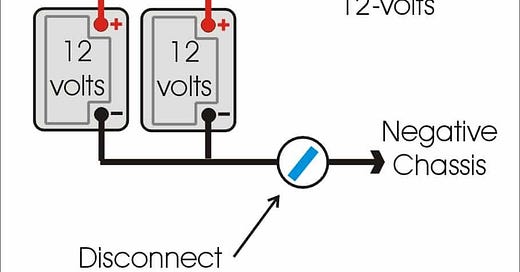Everyone,
Here’s a question I found on the Forest River Forum about storing a Lithium battery over winter.
I installed a new lithium battery in the Spring and have been very satisfied. I was wondering how a lithium battery should be managed during the winter. My battery manual says it should be maintained at 50% SOC. Should I remove it from the trailer tongue and store in my garage or just leave it outside on the tongue. Thanks! WP
Dear WP,
Since a modern Lithium battery in storage only has a loss of around 1% SoC (State of Charge) per month, this would seem to be a simple question. And sinceLithium batteries are okay with cold storage on the trailer tongue, even though the cell should not be charged at temperatures under 32 degrees F.
But that’s another story.
However, most (or possibly ALL) modern RVs don’t have a way to fully disconnect the safety devices from the battery. So even if your RV has a factory installed battery disconnect switch, it may not fully isolate the battery from all low-current loads. That means that your Smoke Detector, LP detector and CO Detector are most likely still powered up.
If that’s the case, then your RV battery can be completely discharged in a matter of days or weeks. I first noticed this problem at an Airstream show where the tech manager said they recommended removing the RV Lithium batteries over the winter, or placing a trickle charger on them for a day every few weeks.
Read my previous article on Airstream parasitic battery discharge during storage HERE.
What’s another solution?
I think that using a small float charger (like a Battery Tender) is a great solution, and there’s even Solar Battery Tenders if you’re not located close to 120-volt power. But another solution is to add a manual battery disconnect switch that will completely isolate the batteries from any parasitic loads during storage.
But first check with your battery manufacturer to confirm the proper SoC to store your batteries at. Some say to charge them up to 100% SoC for storage, others say discharge them to 50% SoC, and some say it doesn’t matter.
This looks like a good isolation solution
You can find a battery master cutoff switch at many marine stores or on Amazon HERE. and I’ll do an installation video later.
One Caveat
Just be sure to turn your battery switch back to the ON position before towing your trailer anywhere since the RV house battery is what supplies 12-volt power to your trailer’s breakaway emergency brakes.
Let’s play safe out there… Mike









You are correct. RVIA does require that all detectors are always powered in new builds. But older RVs probably don’t do this. And yes, you should be able to rewire the detectors over to the switched side of the disconnect switch, and keep the breakaway brake system powered up. But how to do this may not be obvious to non-technical readers.
Reference RVIA and detectors: It hasn't been that long ago. Our 2018 Thor Vegas's Dometic/Atwood LP/CO detector is wired through the USE/STORE switch and the WFCO Power Center, on a dedicated circuit with a 5A fuse. When in Store configuration, the LP/CO detector is unpowered.
Reference the comment on LiFePO4 batteries and cold weather constraints: It does depend on the manufacturer. For example, Dakota Lithium batteries were purposely designed for ice fishing down to -20°F without significant performance loss.
Richard Nickell's blog about winterizing Dakota Lithium batteries on electric-powered sailboats are generally consistent with what Mike said and in reader comments.:
https://dakotalithium.com/faqs/winterizing-lifepo4-batteries/